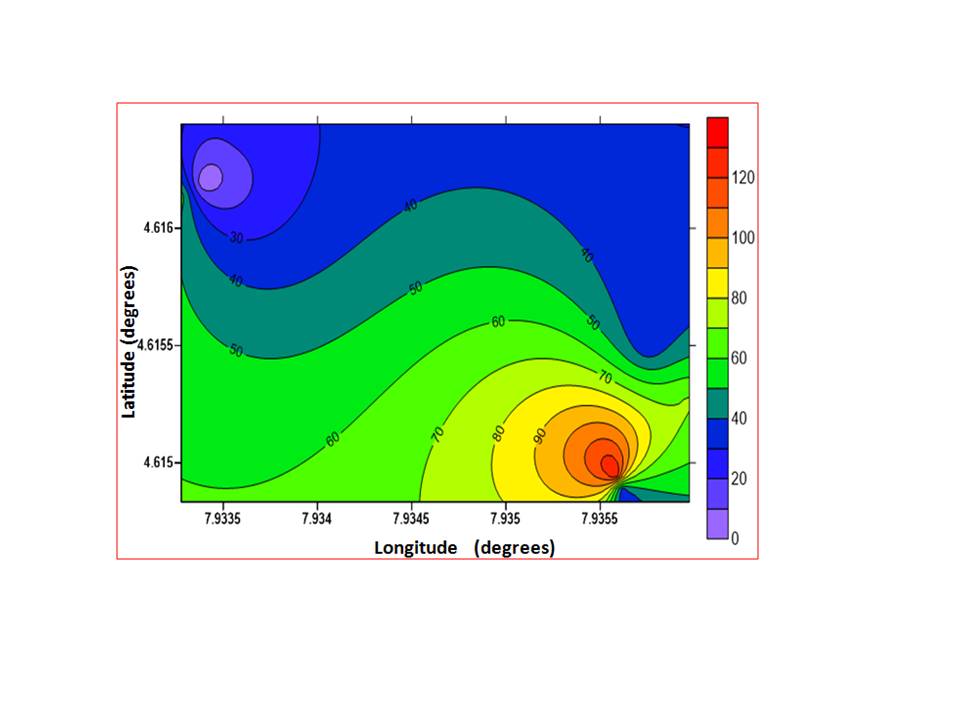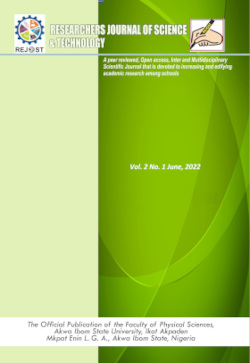Geo-hydraulic characterization of a coastal aquifer system in South-eastern Nigeria with the inverse slope method
Keywords:
Aquifer, Electrical Resistivity Surveying, Hydraulic parameters, Groundwater, EketAbstract
Geophysical surveys were undertaken to determine the geo-hydraulic properties within a major coastal aquifer in Eket, South-eastern Nigeria. Information about geo-hydraulic properties of an aquifer are critical in the management and conservation of groundwater resources, hence it was necessary to characterize this major aquifer’s geo-hydraulic properties. Geo-electrical data was acquired with the Schlumberger configuration and interpreted using the inverse slope method. The interpretation of the geo-electrical data as undertaken by the inverse slope method correlated with lithological information from well logs obtained close to the study area and indicated the presence of three geological layers (motley topsoil, fine sand, and coarse sand). Resistivity values of the overburden were noticeably higher than those of underlying layers, and the resistivity of the subsurface layers ranged from 0.5- 434 Ωm. A performance evaluation of the aquifer was carried out via quantitative characterization of the geo-hydraulic properties which included bulk resistivity, water resistivity, porosity, formation factor, hydraulic conductivity, transmissivity, permeability and tortuosity. Contour plots were generated to show how these geo-hydraulic parameters varied across the study area and empirical formulations were developed to aid in the modeling of aquifer properties in locations with similar geology. This work shows that the inverse slope method is an efficient method for interpreting resistivity data acquired from heterogeneous environments.
References
Abed, A.A., 2014. Hydraulic flow units and permeability prediction in a carbonate reservoir, Southern Iraq from well log data using non-parametric correlation. International Journal of Enhanced Research in Science Technology & Engineering, 3(1), pp.480-486.
Abuseda, H., Kassab, M.A., LaLa, A.M. and El Sayed, N.A., 2015. Integrated petrographical and petrophysical studies of some Eocene carbonate rocks, Southwest Sinai, Egypt. Egyptian Journal of Petroleum, 24(2), pp.213-230.
Al-Fares, W. and Asfahani, J., 2018. Evaluation of the leakage origin in Abu Baara earthen dam using electrical resistivity tomography, northwestern Syria. Geofísica inter-nacional, 57(4), pp.223-237.
Archie, G.E., 1942. The electrical resistivity log as an aid in determining some reservoir characteristics. Transactions of the AIME, 146(01), pp.54-62.
Arétouyap, Z., Bisso, D., Njandjock Nouck, P., Amougou Menkpa, L.E. and Asfahani, J., 2019. Hydrogeophysical characteristics of Pan-African aquifer specified through an alternative approach based on the interpretation of vertical electrical sounding data in the Adamawa Region, Central Africa. Natural Resources Research, 28, pp.63-77.
Aretouyap, Z., Bisso, D., Assatse, W.T., Kana, J.D., Ghomsi, F.E.K., Nouayou, R., Nouck, P.N. and Asfahani, J., 2021. A detailed analysis of hydro-parameters of the Adamawa Plateau watershed derived from the application of geoelectrical technique. Environmental Earth Sciences, 80, pp.1-11.
Asfahani, J., 2013. Groundwater potential estimation using vertical electrical sounding measurements in the semi-arid Khanasser Valley region, Syria. Hydrological sciences journal, 58(2), pp.468-482.
Asfahani, J., 2016. Inverse slope method for interpreting vertical electrical soundings in sedimentary phosphatic environments in the Al-Sharquieh mine, Syria. CIM Journal, 7(2), pp.93-104.
Asfahani, J., Aretouyap, Z. and George, N., 2023. Hydraulic characterization of the Adamawa-Cameroon aquifer using inverse slope method. Water Practice and Technology, 18(3), pp.547-562.
Avbovbo, A.A., 1978. Tertiary lithostratigraphy of Niger delta. AAPG Bulletin, 62(2), pp.295-300.
Babar, M. and Muley, R., 2018. Investigation of sub-surface geology through integrated approach of geological and geophysical studies in the part of South-Eastern Maharashtra, India. American J Water Res, 6(3), pp.123-136.
Bear, J., 2012. Hydraulics of groundwater. Courier Corporation.
Bouadou, R.A.M., Kouassi, K.A., Kouassi, F.W., Coulibaly, A. and Gnagne, T., 2019. Use of the inverse slope method for the characterization of geometry of basement aquifers: case of the department of bouna (ivory coast). Journal of Geoscience and Environment Protection, 7(06), p.166.
Domenico, P.A. and Schwartz, F.W., 1997. Physical and chemical hydrogeology. John wiley & sons.
Edet, A.E. and Okereke, C.S., 2002. Delineation of shallow groundwater aquifers in the coastal plain sands of Calabar area (Southern Nigeria) using surface resistivity and hydrogeological data. Journal of African Earth Sciences, 35(3), pp.433-443.
Ekanem, A.M., George, N.J., Thomas, J.E. and Nathaniel, E.U., 2020. Empirical relations between aquifer geohydraulic–geoelectric properties derived from surficial resistivity measurements in parts of Akwa Ibom State, Southern Nigeria. Natural Resources Research, 29, pp.2635-2646.
Esu, E.O., Okereke, C.S. and Edet, A.E., 1999. A regional hydrostratigraphic study of Akwa Ibom State, southeastern Nigeria. Global Journal of Pure and Applied Sciences, 5, pp.89-96.
Fetter, C.W., 2018. Applied hydrogeology. Waveland Press.
George, N., Obianwu, V. and Udofia, K., 2011. Estimation of aquifer hydraulic parameters via complementing surfacial geophysical measurement by laboratory measurements on the aquifer core samples. International Review of Physics, 5(2), pp.88-97.
George, N.J., Ekanem, A.M., Ibanga, J.I. and Udosen, N.I., 2017. Hydrodynamic implications of aquifer quality index (AQI) and flow zone indicator (FZI) in groundwater abstraction: a case study of coastal hydro-lithofacies in South-eastern Nigeria. Journal of Coastal Conservation, 21, pp.759-776.
George, N.J., Ekanem, K.R., Ekanem, A.M., Udosen, N.I. and Thomas, J.E., 2022. Generic comparison of ISM and LSIT interpretation of geo-resistivity technology data, using constraints of ground truths: a tool for efficient explorability of groundwater and related resources. Acta Geophysica, 70(3), pp.1223-1239.
Gopalan, C.V., 2011. A comparative study of the groundwater potential in hard rock areas of Rajapuram and Balal, Kasaragod, Kerala. J. Ind. Geophys. Union, 15(3), pp.179-186.
Ibanga, J.I. and George, N.J., 2016. Estimating geohydraulic parameters, protective strength, and corrosivity of hydrogeological units: a case study of ALSCON, IkotAbasi, southern Nigeria. Arabian Journal of Geosciences, 9, pp.1-16.
Ibuot, J.C., Okeke, F.N., George, N.J. and Obiora, D.N., 2017. Geophysical and physicochemical characterization of organic waste contamination of hydrolithofacies in the coastal dumpsite of Akwa Ibom State, Southern Nigeria. Water Science and Technology: Water Supply, 17(6), pp.1626-1637.
Ibuot, J.C. and Obiora, D.N., 2021. Estimating geohydrodynamic parameters and their implications on aquifer repositories: a case study of University of Nigeria, Nsukka, Enugu State. Water Practice & Technology, 16(1), pp.162-181.
Inim, I.J., Udosen, N.I., Tijani, M.N., Affiah, U.E. and George, N.J., 2020. Time-lapse electrical resistivity investigation of seawater intrusion in coastal aquifer of Ibeno, Southeastern Nigeria. Applied Water Science, 10(11), pp.1-12.
Kouassi, F.W., Kouassi, K.A., Coulibaly, A., Kamagaté, B. and Savané, I., 2017. Efficiency of inverse slope method in the interpretation of electrical resistivity soundings data of schlumberger type. International Journal of Engineering & Science Research, 7, pp.121-130.
Lobo-Ferreira, J.P., Chachadi, A.G., Diamantino, C. and Henriques, M.J., 2005.Assessing aquifer vulnerability to seawater intrusion using GALDIT Method. Part 1: application to the Portuguese aquifer of Monte Gordo.
Mohamed, H.S., Senosy, M.M. and Abdel Aal, G.Z., 2014. Upgrading of the inverse slope method for quantitative interpretation of earth resistivity measurements. Arabian Journal of Geosciences, 7, pp.4059-4077.
Narayan, P.S. and Ramanujachary, K.R., 1967.An inverse slope method of determining absolute resistivity. Geo-physics, 32(6), pp.1036-1040.
Niwas, S., Tezkan, B. and Israil, M., 2011. Aquifer hydraulic conductivity estimation from surface geoelectrical measurements for Krauthausen test site, Germany. Hydrogeology Journal, 19(2), p.307.
Okereke, C.S., Esu, E.O. and Edet, A.E., 1998. Determination of potential groundwater sites using geological and geophysical techniques in the Cross River State, southeastern Nigeria. Journal of African Earth Sciences, 27(1), pp.149-163.
Rao, B.S.P., Rao, V.V. and Venkateswarlu, N., 2005. Geoelectrical investigations for Flyover Bridge construction in marine environment of Visakhapatnam: A case study. J. Ind. Geophys., 9(1), pp.13-20.
Reijers, T.J.A. and Petters, S.W., 1987. Depositional environments and diagenesis of Albian carbonates on the Calabar Flank, SE Nigeria. Journal of Petroleum Geology, 10(3), pp.283-294.
Sattar, G.S., Keramat, M. and Shahid, S., 2016. Deciphering transmissivity and hydraulic conductivity of the aquifer by vertical electrical sounding (VES) experiments in Northwest Bangladesh. Applied Water Science, 6, pp.35-45.
Shekhawat, M.S. and Chundawat, D.S., 2011. Aquifer Characteristics in and around Keoladev Ghana National Park, Bharatpur, Rajasthan, India. International Journal of Earth Sciences and Engineering, 4(1), pp.45-56.
Short, K.C. and Stäuble, A.J., 1967. Outline of geology of Niger Delta. AAPG bulletin, 51(5), pp.761-779.
Stacher, P., 1995. Present understanding of the Niger Delta hydrocarbon habitat. In Geology of deltas (pp. 257-267).
Soupios, P.M., Kouli, M., Vallianatos, F., Vafidis, A. and Stavroulakis, G., 2007. Estimation of aquifer hydraulic parameters from surficial geophysical methods: A case study of Keritis Basin in Chania (Crete–Greece). Journal of Hydrology, 338(1-2), pp.122-131.
Udosen, N.I. and George, N.J., 2018a. A finite integration forward solver and a domain search reconstruction solver for electrical resistivity tomography (ERT). Modeling Earth Systems and Environment, 4, pp.1-12.
Udosen, N.I. and George, N.J., 2018b. Characterization of electrical anisotropy in North Yorkshire, England using square arrays and electrical resistivity tomography. Geomechanics and Geophysics for Geo-Energy and Geo-Resources, 4, pp.215-233.
Udosen, N. and Potthast, R., 2018c. Automated optimization of electrode locations for electrical resistivity tomography. Modeling Earth Systems and Environment, 4, pp.1059-1083.
Udosen, N.I., 2022. Geo-electrical modeling of leachate contamination at a major waste disposal site in south-eastern Nigeria. Modeling Earth Systems and Environment, 8(1), pp.847-856.
Uwa, U.E., Akpabio, G.T. and George, N.J., 2019. Geohydrodynamic parameters and their implications on the coastal conservation: a case study of Abak Local Government Area (LGA), AkwaIbom State, Southern Nigeria. Natural Resources Research, 28, pp.349-367.
Virupaksha, H.S. and Lokesh, K.N., 2021. Electrical resistivity, remote sensing and geographic information system approach for mapping groundwater potential zones in coastal aquifers of Gurpur watershed. Geocarto International, 36(8), pp.888-902.
Yadav, S.P., Singh, D.N., Singh, A.K. and Prasad, R., 2009. Electrical resistivity imaging for the study of quartz reef using inverse slope method. Current Science, pp.1521-1527.

Downloads
Published
How to Cite
Issue
Section
License
Copyright (c) 2024 Researchers Journal of Science and Technology

This work is licensed under a Creative Commons Attribution-NonCommercial-NoDerivatives 4.0 International License.




